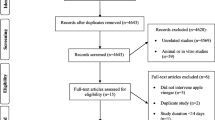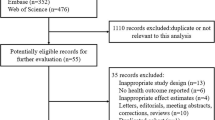Abstract
Multidrug and toxic compound extrusion transporter-1 (MATE1) is a quercetin transporter. We examined the associations of quercetin intake and polymorphism of MATE1 in relation to metabolic syndrome (MetS) in Hallym Aging Study. Quercetin intake and the measurements for MetS were assessed in 2004. Six tagging single nucleotide polymorphisms (SNPs) at MATE1 gene were genotyped in 428 Korean adults in 2012. We found a lower prevalence of MetS with quercetin intake; compared to the lowest quartile, odds ratios (ORs, 95% confidence intervals; CIs) were 0.44 (0.24-0.84) for the 3rd quartile. Individuals with the minor allele of MATE1, rs2453589, tended to have a lower prevalence of MetS compared to those with the major allele (OR=0.69; CI=0.36-1.34). However, interactions between quercetin intake and six MATE1 polymorphisms in relation to MetS were not significant (p for interaction ≥0.37). In conclusion, intake of quercetin was associated with MetS in Korean populations.
Similar content being viewed by others
References
Erdman JW, Balentine D, Arab L, Beecher G, Dwyer JT, Folts J, Harnly J, Hollman P, Keen CL, Mazza G. Flavonoids and heart health: Proceedings of the ILSI North America flavonoids workshop, May 31–June 1, 2005, Washington, DC. J. Nutr. 137: 718S–737S (2007)
Yao LH, Jiang YM, Shi J, Tomas-Barberan FA, Datta N, Singanusong R, Chen SS. Flavonoids in food and their health benefits. Plant Foods Hum. Nutr. 59: 113–122 (2004)
Chen J, Mangelinckx S, Adams A, Wang ZT, Li WL, De Kimpe N. Natural flavonoids as potential herbal medication for the treatment of diabetes mellitus and its complications. Nat. Prod. Commun. 10: 187–200 (2015)
Hertog MG, Hollman PC, Katan MB. Content of potentially anticarcinogenic flavonoids of 28 vegetables and 9 fruits commonly consumed in the Netherlands. J. Agr. Food Chem. 40: 2379–2383 (1992)
Yang YK, Kim JY, Kwan O. Development of flavonoid database for commonly consumed foods by Koreans. J. Nutr. Health 45: 283–292 (2012)
Zhao J, Dixon RA. The’ ins’ and’ outs’ of flavonoid transport. Trends Plant Sci. 15: 72–80 (2010)
Becker ML, Visser LE, van Schaik RH, Hofman A, Uitterlinden AG, Stricker BH. Genetic variation in the multidrug and toxin extrusion 1 transporter protein influences the glucose-lowering effect of metformin in patients with diabetes: A preliminary study. Diabetes 58: 745–749 (2009)
He R, Zhang D, Lu W, Zheng T, Wan L, Liu F, Jia W. SLC47A1 gene rs2289669 G>A variants enhance the glucose-lowering effect of metformin via delaying its excretion in Chinese type 2 diabetes patients. Diabetes Res. Clin. Pr. 109: 57–63 (2015)
Tkac I, Klimcakova L, Javorsky M, Fabianova M, Schroner Z, Hermanova H, Babjakova E, Tkacova R. Pharmacogenomic association between a variant in SLC47A1 gene and therapeutic response to metformin in type 2 diabetes. Diabetes Obes. Metab. 15: 189–191 (2013)
Panchal SK, Poudyal H, Brown L. Quercetin ameliorates cardiovascular, hepatic, and metabolic changes in diet-induced metabolic syndrome in rats. J. Nutr. 142: 1026–1032 (2012)
Rivera L, Moron R, Sanchez M, Zarzuelo A, Galisteo M. Quercetin ameliorates metabolic syndrome and improves the inflammatory status in obese Zucker rats. Obesity 16: 2081–2087 (2008)
Dong J, Zhang X, Zhang L, Bian HX, Xu N, Bao B, Liu J. Quercetin reduces obesity-associated ATM infiltration and inflammation in mice: A mechanism including AMPK-alpha1/SIRT1. J. Lipid Res. 55: 363–374 (2014)
Lee HJ, Park SJ, Kim JH, Kim CI, Chang KJ, Yim KS, Kim KW, Choi HM. Development and validation of a computerized semi-quantitative food frequency questionnaire program for evaluating the nutritional status of the Korean elderly. Korean J. Community Nutr. 7: 277–285 (2002)
Grundy SM. Metabolic syndrome scientific statement by the American Heart Association and the National Heart, Lung, and Blood Institute. Arterioscl. Throm. Vas. 25: 2243–2244 (2005)
Oh H, Quan SA, Jeong JY, Jang SN, Lee JE, Kim DH. Waist circumference, not body mass index, is associated with renal function decline in Korean population: Hallym aging study. PLoS ONE 8: e59071 (2013)
Lee HJ, Park SJ, Kim JH, Kim CI, Chang KJ, Yim KS, Kim KW, Choi HM. Development and validation of a computerized semi-quantitative food frequency questionnaire program for evaluating the nutritional status of the Korean elderly. Korean J. Community Nutr. 7: 277–285 (2002)
Willett WC. Nutritional epidemiology. Oxford University Press, NY, USA. pp. 273–301 (1998)
de Bakker PI, Yelensky R, Pe’er I, Gabriel SB, Daly MJ, Altshuler D. Efficiency and power in genetic association studies. Nat. Genet. 37: 1217–1223 (2005)
Landberg R, Sun Q, Rimm EB, Cassidy A, Scalbert A, Mantzoros CS, Hu FB, van Dam RM. Selected dietary flavonoids are associated with markers of inflammation and endothelial dysfunction in U.S. women. J. Nutr. 141: 618–625 (2011)
Liu YJ, Zhan J, Liu XL, Wang Y, Ji J, He QQ. Dietary flavonoids intake and risk of type 2 diabetes: A meta-analysis of prospective cohort studies. Clin. Nutr. 33: 59–63 (2014)
Loke WM, Hodgson JM, Proudfoot JM, McKinley AJ, Puddey IB, Croft KD. Pure dietary flavonoids quercetin and (-)-epicatechin augment nitric oxide products and reduce endothelin-1 acutely in healthy men. Am. J. Clin. Nutr. 88: 1018–1025 (2008)
Wang X, Ouyang YY, Liu J, Zhao G. Flavonoid intake and risk of CVD: A systematic review and meta-analysis of prospective cohort studies. Brit. J. Nutr. 111: 1–11 (2014)
Zamora-Ros R, Forouhi NG, Sharp SJ, Gonzalez CA, Buijsse B, Guevara M, van der Schouw YT, Amiano P, Boeing H, Bredsdorff L, Fagherazzi G, Feskens EJ, Franks PW, Grioni S, Katzke V, Key TJ, Khaw KT, Kuhn T, Masala G, Mattiello A, Molina-Montes E, Nilsson PM, Overvad K, Perquier F, Redondo ML, Ricceri F, Rolandsson O, Romieu I, Roswall N, Scalbert A, Schulze M, Slimani N, Spijkerman AM, Tjonneland A, Tormo MJ, Touillaud M, Tumino R, van der AD, van Woudenbergh GJ, Langenberg C, Riboli E, Wareham NJ. Dietary intakes of individual flavanols and flavonols are inversely associated with incident type 2 diabetes in European populations. J. Nutr. 144: 335–343 (2014)
Egert S, Bosy-Westphal A, Seiberl J, Kürbitz C, Settler U, Plachta-Danielzik S, Wagner AE, Frank J, Schrezenmeir J, Rimbach G. Quercetin reduces systolic blood pressure and plasma oxidised low-density lipoprotein concentrations in overweight subjects with a high-cardiovascular disease risk phenotype: A double-blinded, placebo-controlled cross-over study. Brit. J. Nutr. 102: 1065–1074 (2009)
Seyoum A, Asres K, El-Fiky FK. Structure-radical scavenging activity relationships of flavonoids. Phytochemistry 67: 2058–2070 (2006)
Nijveldt RJ, van Nood E, van Hoorn DE, Boelens PG, van Norren K, van Leeuwen PA. Flavonoids: A review of probable mechanisms of action and potential applications. Am. J. Clin. Nutr. 74: 418–425 (2001)
Serafini M, Peluso I, Raguzzini A. Flavonoids as anti-inflammatory agents. P. Nutr. Soc. 69: 273–278 (2010)
Lee, JH, Kim Y, Lee H, Jun HJ, Lee SJ. Multidrug and toxic compound extrusion protein1 (MATE1/SLC47A1) is a novel flavonoid transporter. J. Agr. Food Chem. 62: 9690–9698 (2014)
Author information
Authors and Affiliations
Corresponding author
Rights and permissions
About this article
Cite this article
Lee, J.E., Park, H.W., Lee, J.K. et al. Quercetin intake, MATE1 polymorphism, and metabolic syndrome in Korean population: Hallym aging study. Food Sci Biotechnol 25, 1783–1788 (2016). https://doi.org/10.1007/s10068-016-0271-8
Received:
Revised:
Accepted:
Published:
Issue Date:
DOI: https://doi.org/10.1007/s10068-016-0271-8




